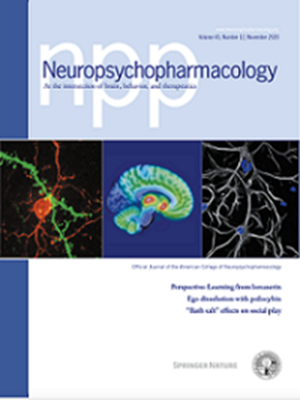Sequential decreases in basolateral amygdala response to threat predict failure to recover from PTSD
IF 6.6
1区 医学
Q1 NEUROSCIENCES
引用次数: 0
Abstract
Amygdala hyperreactivity early-post trauma has been a demonstrable neurobiological correlate of future posttraumautic stress disorder (PTSD). The basolateral amygdala (BLA) particularly is vital for fear memory and threat processing, but BLA functional dynamics following a traumatic event are unexplored. BLA reactivity to threat may be a trait that can predict PTSD and persist over time. Alternatively, BLA responsivity to threat cues may change over time and be related to PTSD severity. As part of a larger, multisite study, AURORA, participants 18–75 years old were enrolled in an emergency department (ED) within 72 h of a traumatic event (N = 304, 199 female). At 2-weeks and 6-months post-trauma, PTSD symptoms, BLA responses to threat (fearful>neutral faces), and functional connectivity (FC) during fMRI were assessed. Generalizability of findings was assessed in an external replication sample of ED patients (n = 33). Two weeks post-trauma right BLA reactivity positively predicted later PTSD severity. However, left BLA reactivity to threat at 6 months post-trauma was negatively associated with PTSD severity at that timepoint (ΔPseudo-R2 = 0.04, IRR = 0.38, p < 0.001). In addition, a decrease in BLA reactivity from 2-weeks to 6-months predicted greater PTSD severity at 6 months (ΔPseudo-R2 = 0.03, IRR = 0.58, p < 0.001). This replicated in the external sample. A reduction in left BLA FC with the dorsal attention network predicted increased PTSD severity over time. These findings support a shift in BLA function within the first 6 months post-trauma that predicts PTSD pathology and stand in contrast to prior conceptualizations of amygdala hyperreactivity as a trait-like PTSD risk factor.

基底外侧杏仁核对威胁反应的顺序下降预示着PTSD恢复失败。
创伤后早期杏仁核高反应性已被证明是未来创伤后应激障碍(PTSD)的神经生物学相关。基底外侧杏仁核(BLA)在恐惧记忆和威胁处理中尤为重要,但创伤性事件后的BLA功能动态尚未被探索。BLA对威胁的反应可能是一种特征,可以预测创伤后应激障碍,并持续一段时间。另外,BLA对威胁线索的反应可能随着时间的推移而改变,并与创伤后应激障碍的严重程度有关。作为一项更大的多地点研究AURORA的一部分,18-75岁的参与者在创伤事件发生后72小时内进入急诊科(N = 304,199名女性)。在创伤后2周和6个月,评估创伤后应激障碍症状、对威胁(恐惧>中性面孔)的BLA反应和功能连通性(FC)。在ED患者的外部复制样本(n = 33)中评估了结果的普遍性。创伤后两周右BLA反应积极预测创伤后应激障碍的严重程度。然而,创伤后6个月左BLA对威胁的反应性与创伤后应激障碍严重程度呈负相关(ΔPseudo-R2 = 0.04, IRR = 0.38, p 2 = 0.03, IRR = 0.58, p
本文章由计算机程序翻译,如有差异,请以英文原文为准。
求助全文
约1分钟内获得全文
求助全文
来源期刊

Neuropsychopharmacology
医学-精神病学
CiteScore
15.00
自引率
2.60%
发文量
240
审稿时长
2 months
期刊介绍:
Neuropsychopharmacology is a reputable international scientific journal that serves as the official publication of the American College of Neuropsychopharmacology (ACNP). The journal's primary focus is on research that enhances our knowledge of the brain and behavior, with a particular emphasis on the molecular, cellular, physiological, and psychological aspects of substances that affect the central nervous system (CNS). It also aims to identify new molecular targets for the development of future drugs.
The journal prioritizes original research reports, but it also welcomes mini-reviews and perspectives, which are often solicited by the editorial office. These types of articles provide valuable insights and syntheses of current research trends and future directions in the field of neuroscience and pharmacology.
 求助内容:
求助内容: 应助结果提醒方式:
应助结果提醒方式:


